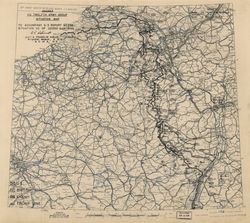 |
Lou Prucha WWII Service
|
 |
Iserlohn, Germany
(Warehouses)

Pilot's Flight Log |

12th Army Group Situation Map 02-Mar-1945 |
piloting 668 Bomb Sq. A-26B-20-DL Invader, Serial # 41-39274, Fuselage code 5H-S.
Click to display the official 416th Bomb Group Mission Folder, Mission Report and Operational Report
scanned to PDF files by the Air Force Historical Research Agency (AFHRA).
Group, Unit and Historical Extracts for Mission 219
"416th Bombardment Group (L) - Group History 1945"
Transcribed from USAF Archives
Again on the 2nd, PPF was employed to attack warehouses at Iserlohn through 10/10 cloud cover. There was no flak. The two boxes were lead by Capt Evans, Lt McCartney and F/O Blount, B&N, and Captain Anderson, Lts Babbage and Shaft, B&N. The mission marked the finish of our first year of operations.
"Attack Bombers, We Need You! A History of the 416th Bomb Group"
Ralph Conte
Page 220
Mission #219 - 2 March - Iserlohn Transport Depot. This depot contained replacement parts for much field equipment plus their required motors, so frag bombs were loaded on our planes, to follow PFF planes again. Captain Evans with Lt. McCartney and F/O Blount as BNs led Box I. Major Price and Lt. Forma, BN flew as deputy to Box I. Captain Anderson with Lts. Babbage and Shaft, BNs, Lts. Brown and Kerns, BN and Captain Pair with Lt. Corum BN led flights. Bombs were dropped through clouds. This was a welcome second "milk-run" for the group.
"Operational History 668th Bomb Squadron (416th Bomb Group (L)) WWII"
Wayne Williams, et.al.
The mission flown today was very near identical to yesterday’s mission, with exception of target and date. We had twelve crews on the loading list, comprising the lead flights of each box. Price & Forma flew Deputy Lead with five of our crews behind them, while Andersen & Babbage with the other five crews were the lead flight of the second box. On this mission, heading the first box was the team of Evans & McCartney. They composed the thirteenth crew on the list. Take-off was in the late morning, and the planes were loaded with 500 lb. "Frags".
The motor transportation depot at Iserlohn, German was the target assigned to the bombers. Two words, namely – "milk-run" described the mission. The target was reached with no flak enroute, and the bombing was carried out by boxes on PFF lead from the altitudes of 13,00 and 13,500 feet. Due to cloud cover, no photo coverage was possible, and the results remained "undetermined". The formation returned to the base with no losses, damage, or casualties, after a journey of 3:30 duration. This ended Group Mission # 219.
Tomorrow should be a day of celebration, as it announces the end of one year of operations. A year that has been full of both sadness and joy.
"History of 670th Bombardment Squadron (L)"
Transcription from USAF Archives
On the following day the Iserlohn Motor Transport Depot was bombed with 500 pound fragmentation bombs using the new type "airburst" fuse, which is operated n a radar principle. Twelve 670th crews participitated in this attack.
"671st Bomb Squadron (L) Unit History"
Gordon Russell and Jim Kerns
The 416th Bomb Group completed its first year of Operations on March 2nd 1945, chalking up Mission No. 219. The target was the Motor Transport Depot at Iserlohn, 10 miles southeast of Dortmund. This depot is a main source for spare parts and motors. Pathfinder technique was used against the cloud-covered target, but it was reported that great damage was done. Flak was nil and all crews returned in tact.
It was on the night of March 2nd 1944 that the Group was alerted for its first mission. Ground crews worked furiously to make ready the ships for this new experience. The formation of A-20s took off at 0830, but got no farther than the English Channel when the fighters failed to rendezvous. The crews got their first sight of the coast of France, which they were to seen many times in the coming months.
"USAAF Chronology of WWII, month by month"
TACTICAL OPERATIONS (Ninth Air Force): In Germany, the 9th Bombardment Division hits 5 bridges, 2 communications centers, 3 ordnance and motor transport depots, several city areas, and 6 targets of opportunity; the objectives are to hinder movement of enemy troops trying to help the German army caught in front of the US Third Army, to obstruct movement in general, and to damage enemy repair and refitting capabilities; 1,700+ fighters escort the bombers, hit special targets, fly armed reconnaissance and patrols, and support the US 3d Armored Division at expanding the bridgehead on the Erft River, the XVI and XIX Corps in the Sevelen, Monchen-Gladbach, and the Neuss area, and the VIII, XII, and XX Corps E of the Prum River, astride the Kyll River, and in the Trier-Saarburg area.